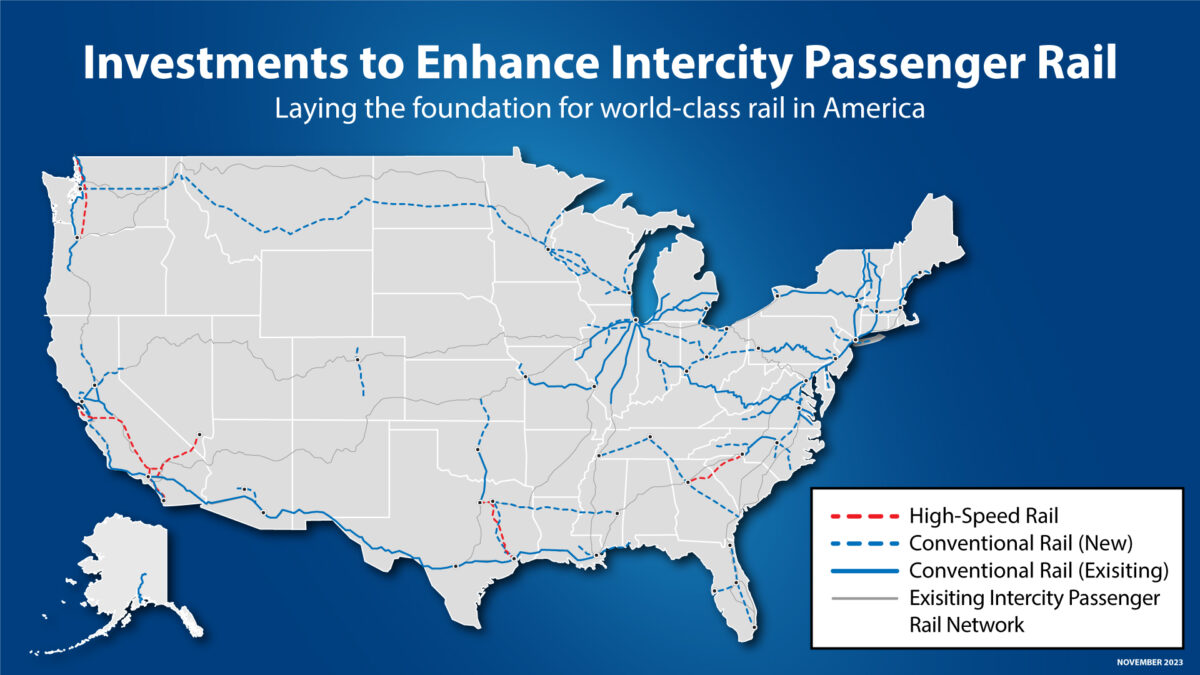To say last week was good for the passenger train industry would be a massive understatement.
At the national level, President Joe Biden released $8.2 billion to fund 10 major projects, including the first high-speed rail line in the U.S. and $34 million to study 69 corridors across the country for new or expanded service.
In this region, the Federal Railroad Administration agreed to pay Pennsylvania $143.6 million toward railroad upgrades to allow a second daily Amtrak trip between Pittsburgh and Harrisburg and funded a handful of corridor studies in this area, including a completely new route that would link Pittsburgh; Columbus, Ohio; and Chicago.
In a briefing for news media on Thursday, U.S. Transportation Secretary Pete Buttigieg said last week’s announcements are the first steps in the Biden administration’s effort to rebuild the nation’s passenger rail system. Biden’s economic stimulus program has earmarked $66 billion for rail improvements over five years.
Buttigieg noted that 150 years ago, the U.S. was a world leader in rail development when the Transcontinental Railroad was completed to allow passengers to ride from east to west across the country. Today, he said, Americans who travel to Japan or Europe come home asking why they can’t have the type of rail service here that that they find overseas.
“Despite that history, America has lagged behind for years now,” the secretary said. “We think Americans should have those same opportunities [they find overseas]. That’s what they ought to be able to expect here.”
Biden announced the first 10 projects Friday at a news conference in Las Vegas, where the gambling and entertainment mecca will be linked by a new 218-mile high-speed rail line with Rancho Cucamonga, California, just outside of Los Angeles. That $3 billion project is expected to make the trip in just over two hours, twice as fast as driving.
But that isn’t the fastest project to be funded. That distinction goes to the 171-mile, $3.07 billion project in central California linking Bakersfield and Merced that will reach speeds of up to 220 miles an hour, the fastest in the U.S.
Other projects would link Richmond, Virginia, and Raleigh, North Carolina ($1.1 billion), and replace the Long Bridge over the Potomac River between Washington, D.C., and Richmond to increase capacity ($729 million).
Buttigieg stressed that the passenger rail expansion will provide other benefits as well. For example, the Las Vegas project is expected to create 35,000 construction jobs and 1,000 permanent positions, serve 11 million passengers a year, take thousands of cars off the road, and eliminate 400,000 tons of carbon dioxide pollution by using electric trains.
The corridor studies, which will cost as much as $500,000 each, are key because they will establish blueprints for the future, Buttigieg said.
Regional projects
For the Pennsylvania area, the immediate benefit will be the FRA’s 80% funding for track and station improvements for the second daily trip between Pittsburgh and Harrisburg. The state had reached agreement in September with Norfolk Southern Railroad to allow additional passenger service and had been prepared to pay for the $180 million in track and station improvements itself if the federal funds didn’t come through.
“The people in Johnstown, Altoona and Greensburg have been pushing for more rail service for a long time,” Pennsylvania Transportation Secretary Mike Carroll said in an interview. “Their advocacy had really pushed this forward, and now it’s happening.”
Norfolk Southern is designing the work, which will include side tracks for freight trains to get out of the way for passenger service and more control signals. Service is expected to start in 2026.
But again, Carroll said he is “excited” about the studies to return service eliminated decades ago and establish new corridors.
The proposed corridor to link Scranton with Penn Station in New York City is the most promising, Carroll said, because existing dormant tracks are already publicly owned. There is no need to make arrangements with freight carriers to accommodate passenger service along that line, but some abandoned track would have to be rebuilt.
That proposal includes three daily trips with stops in Stroudsburg and Mount Pocono in Pennsylvania and Blairstown, Dover, Montclair, Morristown and Newark in New Jersey.
The Reading-to-Philadelphia corridor, which would return service that ended in 1983, is a little more complicated because Norfolk Southern owns the tracks and would have to provide room for passenger service. If it could be arranged, that service would include four to eight daily trips with stops at Pottstown, Phoenixville and potentially Norristown, with connections in Philadelphia to New York City.
Although those projects potentially could require the state to pay hundreds of millions of dollars as its 20% share plus some operating costs, Carroll said, “yes, positively yes” the state would find the money to pay for expanded service.
Mark Spada, president of Western Pennsylvanians for Passenger Rail, said he’s encouraged by the possibilities the corridor studies could create.
“That’s all good news for those corridors,” he said. “If nothing else, it puts those corridors on the map for the future.”
Ohio connections
Several projects in Ohio are a focal point of the corridor studies, and Pittsburgh could be a major benefactor of one of those projects.
For more than two decades, the Mid-Ohio Regional Planning Commission based in Columbus has been pushing to reestablish passenger service through what it calls the Midwest Connector. That corridor would link Pittsburgh with Chicago by way of Columbus and Dayton, Ohio, and Fort Wayne, Indiana, returning passenger service to the two Ohio cities for the first time since 1979.
Columbus is one of the fastest growing urban areas of the country, and returning passenger rail has been a top priority for MORPC Executive Director William Murdock. The agency has gone through a series of studies, even studying innovative hyperloop service using pressurized air pods for that corridor before Virgin Hyperloop decided to concentrate on freight service, so plans are much further along than other projects.
“This is really a transformative process from the FRA,” Murdock said of the money for corridor studies. “This is the last step we need to move forward.”
As soon as the federal money arrives, MORPC will be ready to hire consultants to put together specific plans for the corridor over the next 18 to 36 months. Murdock said the Southwestern Pennsylvania Commission, which oversees transportation planning over a 10-county region that includes Allegheny County, has been “a key partner” to planning the rail corridor.
Murdock said he’s “encouraged” the project will qualify for construction funding because it will be new service and the region already has done most of the preliminary work. Initial plans call for maximum rail speeds of 79 miles an hour in the new corridor but that could be pushed to 110 if there is enough interest, he said.
“We feel really confident this is a great opportunity for Pittsburgh, Columbus and Chicago and the points along the way,” he said.
At least two other corridor studies could have major implications for rail service in Ohio. One will review new service to link the state’s largest cities — Cleveland, Columbus, Cincinnati and Dayton — while the other will look at a route from Cleveland to Detroit by way of Toledo.
Future blueprint
The $66 billion set aside for rail expansion may not cover all of the costs for projects that come out of the corridor studies, said Mitch Landrieu, Biden’s special assistant overseeing the economic stimulus program.
“With this investment, we’re creating history,” he said, noting the first American high-speed rail that is among the projects funded last week.
Buttigieg said the goal is to establish longer-term investment in rail projects. He expects the early successes will increase interest in additional projects developed through the corridor studies.
“What we are doing is creating a platform for future investment,” he said. “I think there will be more appetite for funding projects in the future.”
How soon can the public expect to see expanded service?
“Within a few years, you’re going to see some exciting changes,” he said.
Ed covers transportation at the Pittsburgh Post-Gazette, but he's currently on strike. Email him at eblazina@unionprogress.com.



